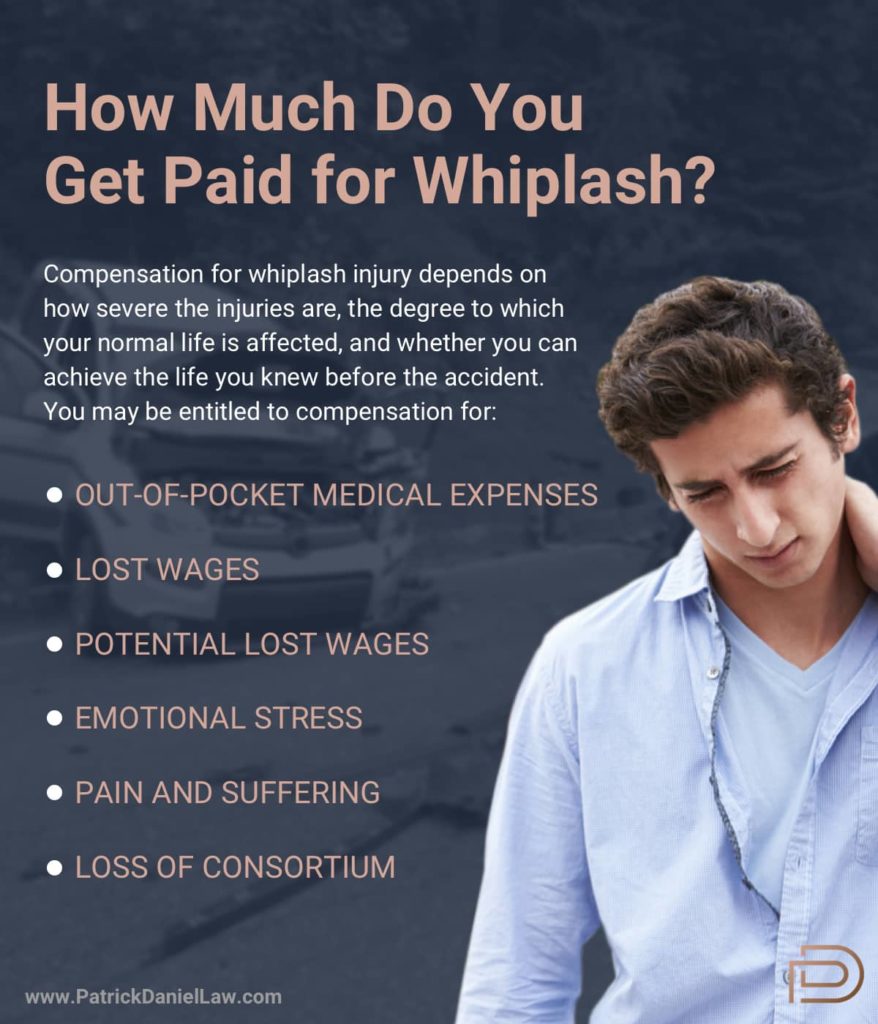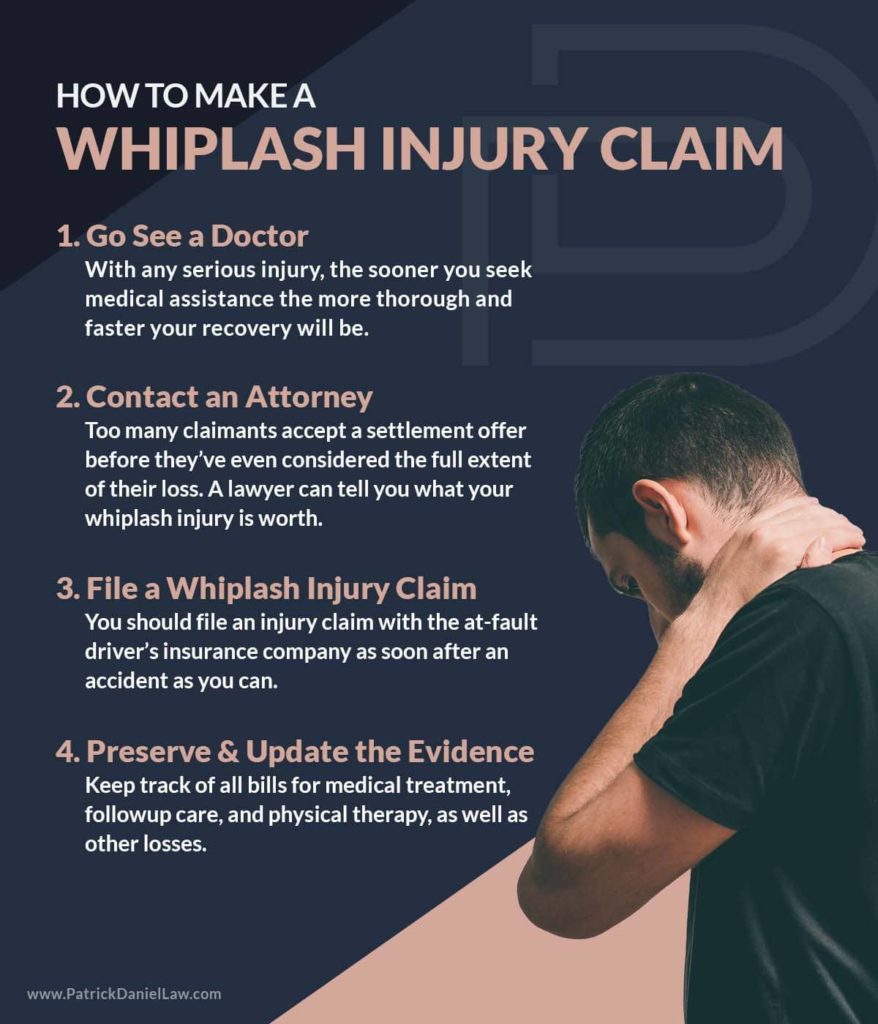
Whiplash injuries, on average, payout roughly $10,000 to $20,000. However, this is just an average whiplash injury settlement. Averages are skewed in whiplash injury cases because some cases can result in extremely large settlements and some can results in extremely small settlement amounts. If you experienced a whiplash injury in Houston, Texas or nationally, and are wondering what your case is worth, please contact us now to talk to a whiplash injury lawyer.

Whiplash is the most common injury resulting from an automobile accident, and most often occurs in rear-end collisions, the most common type of automobile accident. Not surprisingly then, whiplash injury claims are numerous, and billions of dollars are paid out in whiplash awards across the US every year.
Nearly 900,000 lawsuits are filed each year for whiplash injuries and whiplash settlements have almost become standardized because of their frequency. But therein lies a fundamental problem; insurance companies often hide behind their “standard” whiplash injury compensation and refuse to go higher. It makes no difference to them whether the whiplash injury victims’ needs are covered or not.
This is why it is so important to call or contact Patrick Daniel Law if you’ve suffered whiplash injuries in an automobile accident. The average settlement for whiplash is between $10,000 and $20,000, but that’s just the average. There’s a wide range of figures, but those numbers are meaningless if they don’t cover your needs.
Too many claimants accept a whiplash settlement offer before they’ve even considered the full extent of their loss, a whiplash injury lawyer can help you determine the correct compensation. Our Houston whiplash injury attorneys will provide a FREE consultation and let you know what your whiplash injury is worth.
Patrick Daniel and his legal team know whiplash injury law thoroughly. Not only do they know whiplash injury law inside and out, they know the sneaky tricks used by insurance adjusters and their legal representatives to confuse, misdirect and bully victims into agreeing to whiplash settlement offers that are woefully inadequate.

According to the Mayo Clinic, whiplash is a neck injury due to a forceful, rapid back-and-forth movement of the neck. The motion is very much like the cracking of a whip. A whiplash injury can be the result of a fall, physical abuse or, most commonly, a rear-end automobile collision. In some circles, whiplash injuries are called neck sprain.
Recovery is usually routinely affected by a couple weeks’ rest, pain medications and physical therapy. But for some victims, recovery is a long and arduous process, delayed by setbacks and chronic conditions that persist despite all treatment techniques.
Symptoms of whiplash injury generally manifest themselves within hours of an accident, if not immediately. They include:
With any serious injury, the sooner you seek medical assistance the more thorough and faster your recovery will be. This is particularly crucial with whiplash injuries.
Initially, you want to be able to rule out broken bones. There are seven bones (vertebrae) in the neck, and if you’ve endured an impact strong enough to fracture or dislocate a neck vertebrae, you’re probably going to get medical attention at the scene of the accident whether you want it or not.
It is possible to break or dislocate a vertebrae in the neck or spine without realizing it at the time, but the symptoms won’t hide from you for long. It’s always best to see a doctor immediately and get a professional diagnosis.
Another reason for seeing a doctor as soon as possible after an accident is that the success of your claim depends on a confirmed diagnosis of whiplash by a qualified physician. It is absolutely necessary. Even then, the doctor’s diagnosis might be challenged by the insurance company or the opposing attorney if the case goes to court.
Since it has so many symptoms that aren’t readily discernible by anyone other than the victim, whiplash is more closely scrutinized than just about any other injury when a claim is filed. Insurance companies automatically suspect fraud in whiplash cases, because fraud continues to be prevalent in the U.S.
Physicians run tests for whiplash and those tests are generally accepted across the board in the medical community. But that doesn’t necessarily mean they’re automatically accepted by insurance companies. Those tests are valid ONLY if the patient is telling the truth as to what hurts and what his or her range of motion is.
Fair or not, this puts some stern eyes on plaintiffs, who can expect a tough line of questioning from the very beginning of the claim process. If the case goes to court, the attacks on their integrity will ramp up exponentially.
It’s unfortunate that because some plaintiffs tried to cheat the system – and got away with it in many cases – insurance providers have dug in, refusing to make whiplash settlement offers until the claimant has proved their honesty to their satisfaction. Where in other injury claims, there’s a certain amount of trust extended to the claimant, the burden of proof is ramped up when it comes to whiplash cases.
This is why it’s vital to hire a lawyer as soon as possible after your injury. You might take the position that you would rather wait until you encounter a roadblock in your claim for whiplash injury compensation, but it’s almost a certainty that you will. And if you’re concerned that hiring a lawyer immediately after an accident will raise suspicions, don’t worry; the suspicions will already be there.
The term “whiplash” itself seems to trigger thoughts of fraud and distrust. Common internet search phrases like “how much should I settle for a back injury” or “average insurance settlement for back and neck injury” seem to want to avoid the stigma of the term whiplash. Whiplash is a clearly defined condition that the American Medical Association recognizes at face value. If you have suffered a whiplash injury, call it what it is, hire a lawyer and move forward with the process, because there is work to do.
Many insurance companies have handled so many claims for whiplash injury compensation that they’ve created a “standard” whiplash payout scale for internal purposes, but they would love for you to believe it’s an industry-wide standard that has the court’s blessings.
It’s common for a claimant with a back and neck injury to be told, “That’s the standard for this type of injury. We can’t go any higher.”
Yes they can. And they will, if ordered by the court to pay a specified whiplash award.
The amount of compensation for a whiplash injury you can receive depends on how severe the injuries are, the degree to which your normal life is affected, and whether you can achieve the life you knew before the accident.
The average amount of compensation runs from a few thousand dollars to over $20,000, but “average” means nothing other than the result of math calculations. Your injuries pertain only to you and your normal mode of living is known only to you, and it’s rather arbitrary to apply averages for other claimants to your case.
Precedent – what has happened with other whiplash claims – will come into play in your claim, whether it’s fair or not. Here’s some more information on getting fair compensation for a whiplash injury.

As a legal term, “damages” are the amount you are awarded if you win your whiplash lawsuit. They are the types of loss that can’t easily be given a monetary value.
Examples of general damages include:
Special damages refer to losses that can be assigned a monetary value, because they can be verified through bills and receipts for things like out-of-pocket medical expenses and lost wages.
Awarding of general damages is more apt to be tied to precedence than special damages, and that is the element of your whiplash claim that is most likely to be challenged in negotiations or courtroom cross-examination.
An impact strong enough to cause whiplash injuries likely caused additional injuries. They might be minor or serious. Adding them to your overall whiplash claim is simply done, but negotiations can get sticky.
There is essentially no difference in how damages are calculated. Special damages are based on verifiable evidence and general damages are based on pain and suffering.
But the criteria for pain and suffering damages is very subjective, and it’s common for the opposing side to try trivialize the victim’s pain in the other injuries, which could be most anything – broken bones, lacerations, internal bleeding, joint dislocation, facial fractures, contusions, spinal column damage, etc.
Your best strategy here is to work with your injury attorney and take inventory of all the injuries. Note how much they hurt and how much they affect your lifestyle.
With your attorney working on your behalf, you can establish a figure that actually covers your needs. You are entitled to receive compensation for:
The first two categories are easier to calculate than the second two, but ease of calculation has no bearing on how much your case is worth in terms of compensation. Insurance companies and their lawyers will use past histories of similar cases to try to influence the potential whiplash awards, but your case is specific to you.
In most states, mutual aid agreements among police, fire and ambulance services require them to respond to an automobile accident call unless dismissed by the dispatcher. So if you’re in an accident, there will likely be an ambulance at the scene before long.
If you feel any pain that didn’t exist prior to the accident – especially neck and back pain – you should consider taking a ride in the ambulance to the nearest hospital. The sooner you seek medical attention, the sooner you will start to heal. This is also important for the claims process, but your primary objective at this point is getting your injuries treated.
If you are injured severely enough, you will be admitted to the hospital for continuing care, but you may also be treated and released, with a recommendation that you seek follow-up care with a physician. Do not skip this step! Some complications do not present themselves for days, or even weeks later, and you want as much medical intervention as you can get.
It damages your case to be treated and released (or to decline medical assistance at the scene of the accident), followed by a long gap before you sought additional medical intervention. This is a common scenario, however, and you wouldn’t be the first person who mistakenly thought they were fine at first and not-so-fine later on. It won’t spoil your claim altogether, but it will complicate the negotiations.
Patrick Daniel Law has a 98% success rate in winning personal injury lawsuits. Part of the reason for their unmatched winning percentage is that they are experienced enough to recognize a case that has great winning potential and one that is problematic. No attorney wants to accept a case with problems that will be difficult to resolve. Contact Patrick Daniel Law by calling (713) 999-6666 or contact us online.
Companies and insurance firms that represent them do not want you to hire a lawyer. They operate from a position of strength in the early going, when it’s just you versus them, and they like it that way. They might even openly try to talk you out of hiring a lawyer, but you can deduct from their passion to persuade you otherwise that they’re afraid of the consequences for them.
Whether you’ve hired an attorney or not, you should file an injury claim with the at-fault driver’s insurance company as soon after an accident as you can. Do not delay on the basis of not knowing what your final total will be for medical expenses and lost wages. Those factors can always be edited later.
Follow all the steps required in filing the claim – copies of bills, the police accident report and pertinent documents. You don’t want to have your claim delayed, reduced or dismissed altogether on the basis of a technicality. Again, the insurance company can use any misstep on your part as a reason for not paying what it should, but in reality, it doesn’t absolve them of liability. With the assistance of a skillful attorney, you can get past nearly all procedural errors, but it’s better to avoid them than correct them.
However, there is one thing you should not do. DO NOT give a personal statement, either by voice or in writing. You are not required to provide a personal statement, yet you will almost certainly be asked for one, and the caller may insinuate that you are somehow required to provide a statement. (There are extenuating circumstances under which providing a statement could be beneficial to your case, but do not act without consulting your attorney first.)
Nothing impedes the progress of an insurance claim or a court case quite like missing evidence. Whether the evidence was never collected in the first place, misplaced or mishandled, it can make or break your case.
If you file a claim immediately – as you should – your claim will by default be incomplete when you first file it. Medical bills are notoriously slow in arriving, and it often seems as if they’ll never end; Plus, expenses for follow-up care, physical therapy and peripheral expenses have not arrived yet. Take as much care with preserving this evidence as you did with the initial documents.
As already mentioned, your testimony is subject to challenge and vulnerable to misinterpretation. Hard evidence is unflinching.
The entire process, if your claim becomes a lawsuit, can take from six months to over a year before final verdict. But 95 percent of all personal injury cases are resolved prior to going to trial.
It’s likely that the insurance company will contact you early in the process, usually within a couple of weeks. They might have an offer at that time (careful, though; it’s apt to be a disappointing one), or they might want to obtain information and to gain your confidence.
Reaching a pre-trial agreement can take anywhere from two to six months, but there are many exceptions and so many variables that expecting your case to follow the pattern of other cases would be an exercise in futility.
Whiplash cases create the perfect venue for insurance companies wanting to avoid whiplash awards that they don’t agree with. They often perform Jekyll and Hyde routines with claimants (before the case goes to court) and plaintiffs (after the case goes to court), coming on cheery at first and then getting stern and intimidating when it suits their purposes.
“Hi! Nice Day Isn’t It! Just Sign Here.”
Generally, the first communication you’ll receive from an insurance company will sound like Mr. Rogers is welcoming you to his neighborhood. They may open up with genuine-sounding concern for your recovery, and then, after they’ve won your confidence, move along to the business at hand.
For them, the business at hand is to get your signature on a whiplash settlement, a settlement that they will promote as being very generous, a settlement that they are sure will take care of your needs and happily send you on your way back to the life you once knew.
You can be assured that the first offer will be an amount the insurance company can live with. But it will be an amount you can’t live with. If you decline the offer or mention that you want to take some time to think about it, they may tell you that there is a time limit, and that the offer will no longer be valid after a certain date.
Insurance companies can extend or withdraw offers as much as they like, impose deadlines and write conditions on settlement, but none of that reduces their obligation to pay whiplash injury compensation to those who deserve it.
Insurance companies will often attempt to advise claimants that the offer extended to them represents an average settlement for whiplash, something all insurance companies believe is reasonable. This probably will come with a take-it-or-leave-it attitude, along with a prediction that any attempt to gain a better settlement will meet with failure. Unless you talk to a whiplash injury lawyer, you won’t know the limit amount for your specific case.
“We Just Need a Statement From You”
Never give a statement to the insurance company or the opposing attorney. Statements can be misinterpreted, taken out of context or used against your credibility if the case goes to court.
The insurance representative will likely mention that they have already gotten statements from the other parties involved or witnesses, and present this as an opportunity for you to give “your side of the story.” In actuality, what they are looking for are misstatements, or comments that can be manipulated or comments that might have been true at the time they were uttered, but are no longer true due to changes in your situation.
The law is on your side in this regard. You do not have to provide anyone, not even your own employer, a statement regarding the accident’s occurrence, your health status or state of mind. You do not have to say anything, period.
You should, however, speak openly with your attorney to provide him or her with all the information needed to litigate your case.
There is a difference between a statement and a deposition. If you are asked to provide a deposition, it should be approached with the same demeanor as courtroom testimony, because in a way it is. In a deposition, all parties from both sides are present, and you are placed under oath.
You must tell the truth when providing a deposition, and answer questions from either side. This is part of the discovery process in a legal case, where the facts are gathered and refined. As long as they’re pertinent to the case, lawyers may ask any question that comes to mind. They can be tough questions, annoying questions and questions that carry an undercurrent of suspicion.
Your job, if you’re deposed (asked to provide a deposition) is simply to tell the truth. You will likely not be the only person deposed. Eyewitnesses, expert witnesses and those who have some knowledge pertinent to the case can be asked to provide a deposition.
YouTube channel editors like to hold internet users’ attention by promising some spectacular video moment and typing “Wait for It” in the title so the viewers will hang on through the boring prelude to the big occurrence, which may or may not be all that spectacular. Essentially, that’s what some insurance companies do when processing a claim. They promise a satisfactory conclusion to the process if the claimant will just be patient through endless delays.
The reasons for delays are plenty and they have a storage room full of them that they can trot out whenever they feel like it. Sometimes, they use these complications to the process to insinuate that the claimant has an invalid claim, or that it lacks in some crucial element.
During this often arbitrary delay, they might mention that the offer you declined in the early going is still available, if you’re tired of waiting. Their benefit in delaying is that every day that goes by with the claim unresolved is another day that they don’t have to write a big check.
If the delay lasts significantly over a year (and many do) it begins to close the window of opportunity for a lawsuit. In most states the statute of limitations on filing an injury lawsuit is two years.
Whiplash is easily the most-contested injury in the claim process, partly because there have been so many cases of fraud in the past. But also, there are no outwardly discernible indications of how much pain a person is in, or how flexible a person’s neck and back are. Some people get over a frightening crash and resulting whiplash injury in just a few weeks and some people are still struggling months later.
For these reasons, insurance adjusters and defending attorneys come on strong when cross-examining a victim of whiplash. They will often bring in their own expert witnesses whose testimony will oppose yours or your doctor’s. They will contend that the injuries are not as bad as you have been claiming them to be, or even that you had a preexisting condition. They will attempt to twist every word of your testimony and try to pin you down on points that suggest you’re not as badly injured as you claim to be.
For a whiplash injury case to move forward through the court system, the plaintiff (with the aid of his or her attorney) must secure the testimony of an independent medical examiner (IME) who is not regularly associated with either you or the law firm representing you. The defense can also bring in their own IME, but keep in mind that “independent” doesn’t necessarily mean “impartial.” The defense team’s IME might be someone hand-picked for his propensity for downplaying the severity of injury claims.
The overwhelming majority of whiplash injuries occur as a result of automobile accidents, specifically rear-end collisions, the most common kind. But whiplash injuries can be suffered in sports mishaps, falls and incidents of domestic abuse.
For many people, a rear-end collision can only be the fault of the trailing car, the one that does the hitting. But in this day of road rage and staged accidents, the issue of who’s at fault in a rear-end collision is not as obvious anymore.
Dash cam recordings of rear-end collisions show that sometimes, for whatever reasons, the car in front backs into the car behind it, or brakes so suddenly that the trailing vehicle doesn’t have time to stop. This could be accidental or it could be deliberate brake-checking. There is also the “swoop and squat,” a clearly intentional scam where one car suddenly swerves to expose a slow-moving car ahead that can’t be avoided by the car behind it.
These are infrequent occurrences but are frequent enough to give insurance companies motivation to challenge accident victims about their driving just prior to the crash. They don’t have to prove that the claimant was at fault. They just need to make the claimant uneasy enough to sign off on a whiplash settlement that favors the insurance company.
Understandably, you might be reluctant to call your own insurance company to pay bills when you were the innocent party in an accident. The other driver’s insurance, who is already raising questions about your claim isn’t going to issue any advance checks to “tide you over,” so you are left with the choice of letting the bills go unpaid, paying them out-of-pocket or filing a claim with your own insurance company.
If you have car insurance, you have already paid for coverage against uninsured drivers and for situations (called gaps) where money is needed prior to the final resolution of a claim. For most insurance carriers, this is an appropriate time to take advantage of the policy. Insurance carriers differ on this policy, so check your policy and call your agent if you have any questions.
In many cases, your attorney can negotiate with medical providers, advise them of your situation and persuade them to let unpaid bills wait until the matter is resolved. This will help prevent interruptions in your medical care, protect your credit rating and provide you with some peace of mind during a troubling episode in your life.
Whiplash is just one of a medical category of back, spine, neck and head injuries. If you suffer whiplash, you may also suffer any of these related injuries that are serious enough on their own, but when combined with whiplash pose a very substantial risk.
This reiterates the importance of seeing a doctor as soon as possible after an accident. A diagnosis of whiplash does not rule out any of these other conditions. Left untreated, they can lead to chronic suffering, paralysis and even death.
Coup Contrecoup is a head injury that occurs in a sequence very much like the sequence that produces whiplash. It occurs when the head strikes an object (or an object strikes the head) and the recoil effect causes the brain to collide with the skull on the opposite side. The action can be front-to-rear, rear-to-front or side-to-side. Coup is the initial impact, contrecoup is the diametrically opposed injury.
Whiplash often includes contrecoup. The bruising of the brain is very serious. The contusion can cause problems with reasoning and decision-making, speaking, comprehension of speech and memory. More serious impacts can result in difficulty swallowing, vertigo, coordination issues, weakness in the muscles, paralysis and sensory perception.
Damage to the spinal column, connecting tissue, spinal cord and nerves can cause a variety of very grim conditions, including weakness, sensation and any motor functions below the point of the injury.
When EMTs arrive at the scene of an accident and do a triage of the injured parties, one of the first things they do if they suspect a spinal column injury is to ask the patient to move certain body parts – fingers, arms, legs and toes. They may also test the sensations in those areas.
The severity of the spinal cord injury can result in possibly permanent conditions of:
Symptoms to be aware of after a spinal cord injury include extreme back pain, weakness, loss of coordination or paralysis in any part of the body; numbness or tingling; loss of bladder or bowel control; difficulty with walking or balance; impaired breathing; odd twisting of one or more of the extremities.
Headaches that radiate from the base of the skull frequently result from a whiplash injury. Nearly two thirds of whiplash victims also suffer from whiplash headaches. These are the result of cervical facet joints becoming inflamed and irritated, either directly from the whiplash motion or indirectly, as a result of swelling in the affected area.
The treatment for whiplash headaches is physical therapy and mild anti-inflammatory medications. If pain persists – even when the rest of the injuries have improved – steroid/anesthetic injections in the facet joints of the spine may provide more thorough relief, but even those methods have their limitations.
Doctors have achieved satisfactory results from the use of radio frequency pain blocks.
A pinched nerve occurs when too much pressure is applied to a nerve by surrounding tissue, bones, cartilage, muscles, or tendons. The pressure impedes the nerve’s function, resulting in pain, numbness, tingling or loss of strength.
Contusions and edema (swelling) can also cause pinched nerves. This can be an additional symptom of whiplash, a symptom that might take awhile to develop. For the most part, a pinched nerve will heal with a few days’ rest, but in severe cases, surgery might be required.
If you entered the medical realm by way of an ambulance ride to the hospital, many of the decisions for treatment were made according to protocol based on your injuries and the evidence thereof. You can go along with or challenge those decisions, but it’s considered a courtesy to initially give professionals the opportunity to prove why they’re professionals.
If you are released to your own care, with recommendations on who to contact for further care, you can proceed with the next step. These are all good options after a whiplash injury:
While there’s very little you can do to keep from being rear-ended by another car at the stoplight, there are some precautions you can take to decrease your risk of suffering a whiplash injury. They won’t prevent you from a hard impact at high speed, but they will help in the case of a low-speed crash (which covers most rear-end collisions anyway).
Hiring a whiplash attorney to represent you in a personal injury case makes an immediate difference. When it was just you versus the insurance company, the insurance company made the rules.
When an attorney enters the process, the game changes. The tactics intended to bully, coerce and intimidate the claimant generally subside. While there might be a little bit of push-back that includes one last-ditch effort to get you to sign a whiplash settlement offer, the insurance companies generally prepare for a different sort of conflict going forward.
The truth is, no one really wants your case to go to trial, not even your own attorney. All parties hope for an out-of-court settlement, and work toward that end, but some cases, there is no resolution short of a bench trial or jury trial. Some law firms seem to exist merely on their abilities to gain settlements out of court, and shy away from actually making an appearance in a courtroom. This reluctance to go to trial can result in accepting a counteroffer that falls short of what a plaintiff deserves.
Trial lawyers have the experience and patience for a trial. Patrick Daniel Law is prepared to go to trial, and does go to trial frequently, resulting in some immensely satisfying settlements. Patrick Daniel Law specializes in catastrophic injury, product liability, 18-wheeler accidents, maritime injuries, admiralty law and much more.
If Patrick Daniel Law accepts your case, there will never be a fee other than a contingency fee. These types of fees are deducted from the final settlement. If you or a loved one was injured, contact Patrick Daniel Law today at (713) 999-6666 or contact us online for a FREE case evaluation.
 Top Truck Accident Lawyer in Pasadena
Top Truck Accident Lawyer in Pasadena Best of The Best Attorneys
Best of The Best Attorneys Best of the Best Houston Chronicle 2021
Best of the Best Houston Chronicle 2021 Best Motorcycle Accident Lawyers in Houston 2021
Best Motorcycle Accident Lawyers in Houston 2021 American Association for Justice Member
American Association for Justice Member The National Trial Lawyers 2016 – (Top 40 under 40)
The National Trial Lawyers 2016 – (Top 40 under 40) Multi-Million Dollar Advocates Forum 2016 (Top Trial Lawyer)
Multi-Million Dollar Advocates Forum 2016 (Top Trial Lawyer) Million Dollar Advocates Forum 2019 (Top Trial Lawyer)
Million Dollar Advocates Forum 2019 (Top Trial Lawyer) America’s Top 100 Attorneys 2020 (High Stake Litigators)
America’s Top 100 Attorneys 2020 (High Stake Litigators) Lawyers of Distinction 2019, 2020 (Recognizing Excellence in Personal Injury)
Lawyers of Distinction 2019, 2020 (Recognizing Excellence in Personal Injury) American Institute of Personal Injury Attorneys 2020 (Top 10 Best Attorneys – Client Satisfaction)
American Institute of Personal Injury Attorneys 2020 (Top 10 Best Attorneys – Client Satisfaction) American Institute of Legal Advocates 2020 (Membership)
American Institute of Legal Advocates 2020 (Membership) Association of American Trial Lawyers 2018 - Top 100 Award recognizing excellence in personal injury law
Association of American Trial Lawyers 2018 - Top 100 Award recognizing excellence in personal injury law American Institute of Legal Professionals 2020 (Lawyer of the Year)
American Institute of Legal Professionals 2020 (Lawyer of the Year) Lead Counsel Verified Personal Injury 2020
Lead Counsel Verified Personal Injury 2020 The Houston Business Journal 2021
The Houston Business Journal 2021